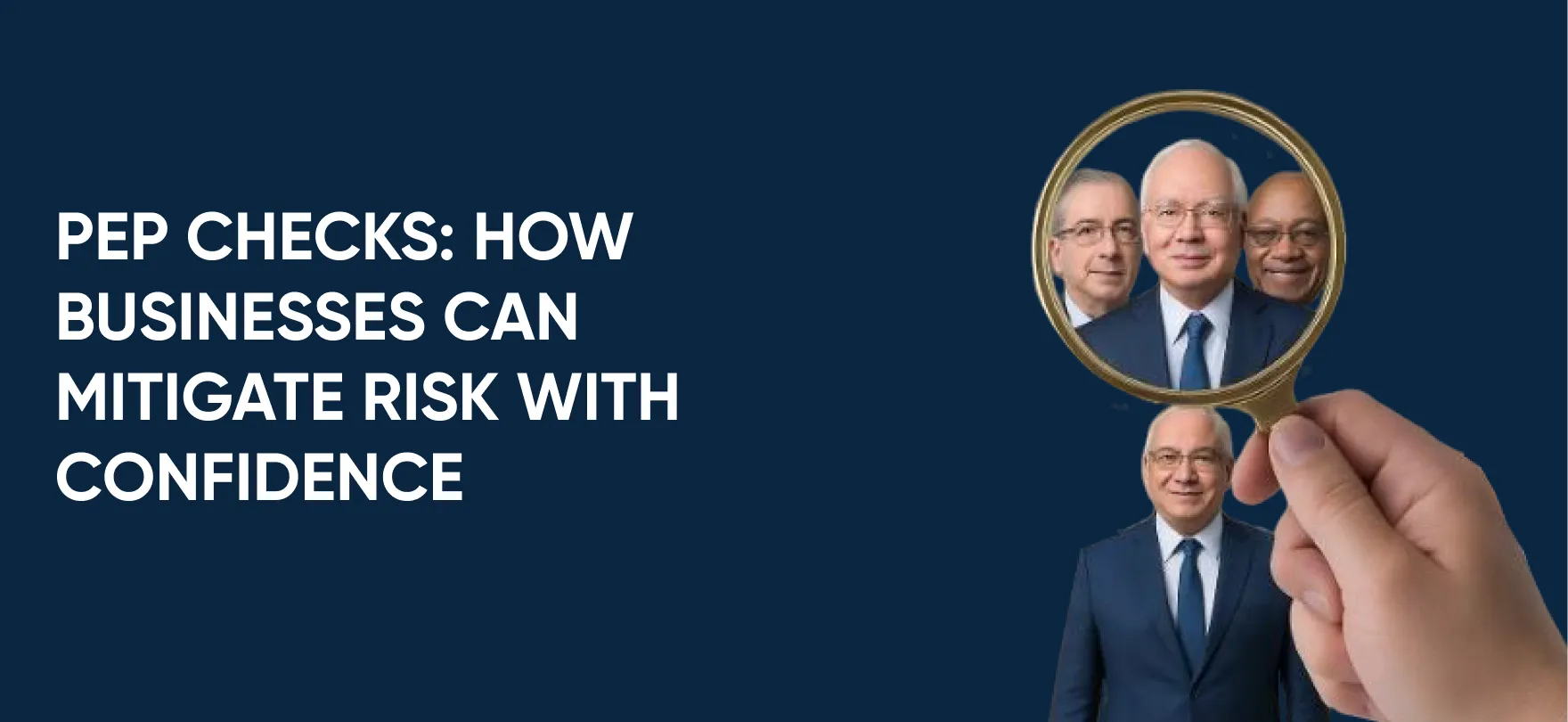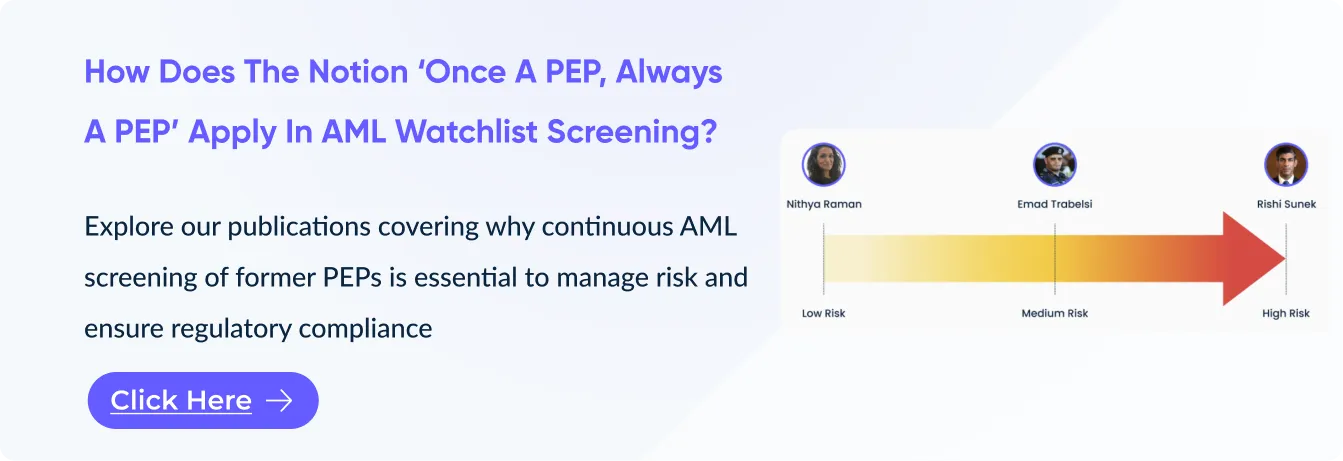
PEP Checks: How Businesses Can Mitigate Risk with Confidence
Lord Acton’s timeless truth, “Power tends to corrupt, and absolute power corrupts absolutely”, holds a deep connection to the contemporary financial landscape.
High-profile cases like Brazil’s Operation Car Wash, Malaysia’s 1MDB scandal, and Africa’s state inquiry for Isabel dos Santos’ corruption case have clearly revealed how politically exposed persons (PEPs) can be at the center of vast corruption and money laundering schemes.
These high-profile incidents underscore the importance of managing the risks tied to individuals in positions of power.
This leads to a critical question for those in charge: Are financial institutions integrating advanced screening tools to mitigate emerging risks linked with PEPs?
For financial institutions keen on building a solid anti-money laundering (AML) framework, a thorough understanding of PEPs and their regularly changing risk status, the continuously changing regulatory landscape, and effective due diligence is crucial.
This is where PEP checks become indispensable. Financial institutions can build a proactive line of defense against reputational harm, regulatory breaches, and inadvertent involvement in global corruption by systematically identifying and evaluating politically exposed persons.
Far from being a routine task, PEP checks serve as a frontline defense against reputational and financial exposure.
To put this into perspective, it’s essential to first understand who are Politically Exposed Person (PEP), what PEP checks are, and how they work within a compliance framework.
Who are Politically Exposed Persons (PEPs)?
An individual who is offered a prominent public position or duty, which adds to their influence and power to manipulate their authority, is termed a politically exposed person (PEP).
In light of Article 52 of the United Nations Convention against Corruption (UNCAC), PEPs are defined as “ subjects who are or have been titled with prominent public positions in the past or present, including their family members and close associates.”
FATF Recommendations 12 and 22 outline the essentials of checks for PEPs from foreign, domestic, and international organizations, as well as their families and close associates. FATF Guidance: Politically Exposed Persons.
What are PEP Checks?
Politically Exposed Person (PEP) checks involve identifying individuals against PEP databases and restricted lists to assess potential risks.
It assists financial institutions and obliged entities in evaluating the potential risk while onboarding or maintaining relationships with individuals in prominent public positions.
Although being categorized as a PEP does not imply misconduct or criminal participation, it does indicate the need for more enhanced due diligence.
This enables institutions to proactively manage potential exposure to bribery and corruption, or other financial crimes associated with influential individuals, thereby maintaining compliance and reputational integrity.
Why are PEP Checks Important?
PEP checks are an essential aspect because politically exposed persons are generally considered high-risk due to their potential involvement in corruption, bribery, or other financial crime.
PEPs pose unique risks to financial institutions and businesses due to their potential access to public funds and ability to influence policy or procurement.
Without effective PEP screening, organizations may unknowingly facilitate illicit financial flows, which can lead to significant legal penalties, reputational damage, and regulatory sanctions.
Moreover, regulators worldwide mandate enhanced due diligence on PEPs to prevent misuse of the financial system for illegal activities. Conducting thorough PEP checks helps businesses:
- Identify and assess the level of risk associated with customers or counterparties.
- Implement tailored monitoring and controls based on the risk profile.
- Ensure compliance with international AML standards and local regulatory requirements.
- Protect the organization’s reputation by avoiding involvement with corrupt or high-risk individuals.
- Demonstrate transparency and commitment to ethical business practices.
FATF recommendation 12 guides financial institutions to integrate appropriate risk-based measures if they want to detect whether their clients are politically exposed or not.
The Malaysian 1MDB scandal vividly illustrates the significance of PEP checks, as this case shows, powerful political figures can launder billions of dollars across global financial institutions.
The shortcomings in flagging these politically exposed persons eventually resulted in massive fines from the regulatory authorities, including over $6.5 billion in combined penalties and settlements against Goldman Sachs by U.S. and Malaysian authorities.
When are PEP Checks Required?
PEP checks are required in the following situations:
- Customer onboarding processes: PEP checks are conducted at onboarding to identify any politically exposed persons before establishing a business relationship.
- Change in the customer’s risk profile: PEP status changes from time to time, with a change in their role, position, or power. Whenever an election is conducted, the PEP status changes for that particular region. This change in status brings a change in PEP risk level, which ultimately requires customized risk profiling and risk assessment.
- Enhanced Due Diligence (EDD) Processes: To assess high-risk customers thoroughly, the PEP check is intensified during Enhanced Due Diligence. This often includes gathering additional documentation and conducting more in-depth background checks.
Instead of these four tiers, the FATF advocates that financial institutions evaluate politically exposed persons using a dynamic set of factors, which include:
- The individual’s political prominence
- The jurisdiction in which they operate
- The level of control over public funds
- Connection to high-risk sectors
- Exposure in credible adverse media sources
How Does the PEP Check Process Work?
The screening for PEPs should align with a financial institution’s risk-based approach. An efficient AML system supports this process through automated screening tools that enhance the due diligence process during initial onboarding and through periodic reviews triggered by specific events requiring Enhanced Due Diligence (EDD).
The real value of PEP checks lies in ongoing Monitoring and risk Screening, particularly when it comes to mitigating financial crime risks over time.
-
Global Screening Data
Once the onboarding system verifies a customer’s identity, the next step screens the individual’s name and relevant identifiers against up-to-date global PEP data. These include:
- Government and regulatory sources
- International political registries
- Reputable commercial data providers
- Sanctions lists and criminal records
-
Risk Scoring
After screening customer information, a risk score is assigned on the basis of one of the three due diligence levels: simplified, regular, or enhanced. MLROs can also configure risk scores based on their company’s compliance program.
For example, risk scores can be added for the following instances:
- Reside in a high-risk country.
- Qualify as a politically exposed person (PEP), a family member, or an associate.
- Hits in adverse media for specific keywords such as ‘Corruption’, ‘Bribery’, etc.
-
Enhanced Due Diligence
Enhanced Due Diligence is implemented to investigate the backgrounds and activities of higher-risk customers, checking for potential risks associated with them.
PEPs, due to their high-profile roles, are assigned higher risk scores due to their increased exposure to financial crimes like money laundering, corruption, and tax evasion. As a result, Enhanced Due Diligence is required to thoroughly assess and manage these rising risks.
Institutions can prioritize PEPs for detailed evaluation and implement appropriate measures by incorporating required risk scoring.
This entails:
- Verifying the origin of funds to ensure they are legally obtained.
- Checking for any negative media associations related to corruption or financial crimes.
- Continuously tracking transactions for any suspicious or unusual behavior.
- Maintaining clear records of findings for compliance and regulatory requirements.
MLROs are required to maintain comprehensive case management documentation and an audit trail to note their actions, transaction patterns, and financial behavior at each stage of screening.
This helps the compliance officers understand their perspective when scrutinizing specific high-risk cases.
-
Ongoing Monitoring
Ongoing monitoring is configured to assess changes in the customer’s risk profile on a frequent basis. It generates alerts if a customer suddenly adopts or upgrades a PEP status or experiences adverse media coverage.
Challenges of PEP Checks
Financial institutions frequently experience hurdles in their Politically Exposed Person checks, which can impact their compliance efforts adversely. These challenges range from PEP screening data to evolving regulatory complexities.
These challenges are:
- Variation in Definitions and Legislation: Regulatory definitions of PEPs differ across jurisdictions, including the roles that qualify and the duration of PEP status after leaving office, which complicates consistent global screening.
- Domestic vs. foreign PEPs: Failing to distinguish between domestic vs. foreign PEPs, or high vs. low influence roles, can result in resource misallocation.
- Dynamic PEP Status: Individuals can gain or lose PEP status over time, such as after elections, appointments, or retirements, making it difficult to maintain accurate records without timely updates.
- Lack of Jurisdiction-Specific Coverage: Some screening tools lack local data, especially in controversial or high-risk regions, increasing the risk of missing regionally relevant PEPs.
- Limited Data Not Covering Each Region: Incomplete global coverage due to missing public records, language barriers, or outdated sources leaves critical gaps in identifying politically exposed individuals.
- Difficulty in Mapping RCAs: Identifying relatives and close associates is complex due to opaque or unavailable relationship data, often scattered across multiple sources or not publicly disclosed.
- Poor Risk Categorization: Incorrectly assessing the risk level of PEPs can lead to insufficient due diligence and missed red flags, increasing the risk of overlooking potential financial crimes.
Key Performance Indicators for PEP Checks
These are the key performance indicators through which compliance officers can benchmark PEP screening platforms, ensure regulatory compliance, and mitigate risks.
- Ensure the screening from Credible Data Sources
- Confirm whether the platform supports a risk-based approach and offers continuous monitoring of comprehensive global PEP and RCA data with frequent updates.
- Incorporate proper CDD, EDD, and adverse media screening with risk-tagging
- Prioritize tools with multilingual support to screen PEP from any region with accurate results.
Power Up Your PEP Checks with AML Watcher
Are you facing consistent PEP challenges and searching for a way out?
We’ve got your back!
AML Watcher delivers up-to-date PEP and RCA data from over 235 jurisdictions, updated every 15 minutes, including conflicted or controversial regions.
AML Watcher supports all PEP risk levels (1-4), including both high- and low-risk local and foreign PEPs, allowing institutions to conduct complete risk assessments while efficiently managing resources and remaining compliant.
It integrates PEP definitions from the FATF, FinCEN, FCA, Wolfsberg, and other sources into a one database for jurisdiction-specific compliance.
It accurately maps PEPs and their related close associates (RCAs) for better risk categorization based on influence, behavior, and media presence.
It updates PEP data every 15 minutes to ensure real-time risk accuracy and quick adaptation to regulatory changes.
It allows fully customizable PEP screening to align with the institution’s risk appetite and regulatory needs.
Our data empowers AML compliance teams to strengthen due diligence, reduce false positives, and meet evolving regulatory requirements with confidence.
We are here to consult you
Switch to AML Watcher today and reduce your current AML cost by 50% - no questions asked.
- Find right product and pricing for your business
- Get your current solution provider audit & minimise your changeover risk
- Gain expert insights with quick response time to your queries







